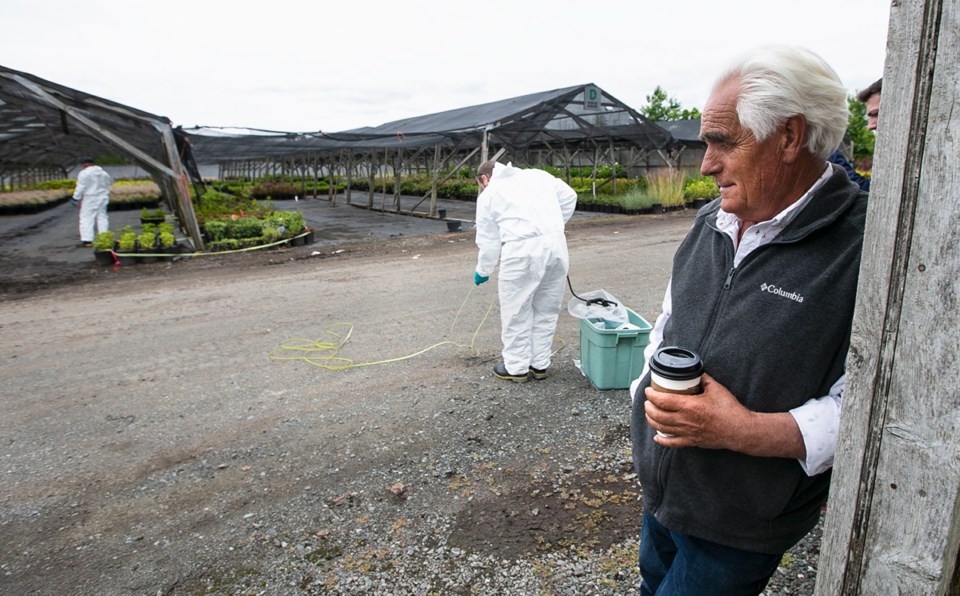Phytophthora, Plant Destroyer — you might think it was a comic-book villain, rampaging across the big screen, chased by the likes of Scarlett Johansson and Robert Downey Jr. in shiny leotards.
But Phytophthora (“plant destroyer” in Greek) is a micro-organism. A kind of brown algae that originated in water, it now attacks land plants.
It still loves water, however, thriving in humid environments. Its spores spread via runoff, rain splash and wind-driven rain, as well as contaminated irrigation water, soil or gravel. It also spreads through contact with infected plant material.
The micro-organism has many faces — at least 150 species, and many strains within each species. Each attacks different host plants. Each harms its hosts to a different degree. Some live in the soil and attack plants’ roots. Some kill the entire plant. Others kill new growth. Others cause lesions or reduce growth.
It can be as destructive as a Marvel villain. One species — P. infestans — destroyed Ireland’s potato crop in the 1840s, starving one million people and forcing another million to emigrate.
Another species causes sudden oak death. It has killed 50 million native oak trees in California and Oregon in the past 30 years by causing lesions on the trunks that strangle the trees.
Canadian Food Inspection Agency inspectors found this species — P. ramorum — on plants at Saanichton’s Island View Nursery in July. The inspectors promptly closed and quarantined the nursery while they collected and tested more samples. Two weeks later, they permitted the nursery’s owner to reopen about 40 per cent of the 80-acre operation.
The region’s nurseries have dealt with P. ramorum before. The first introduction occurred in 2003. It had come in on nursery plants imported for sale in B.C. from California.
“When Phytophthora ramorum was found on nursery stock in B.C. that first time, we worked closely with the CFIA, Agriculture Canada, the B.C. Landscape Nursery Association and others to develop protocols based on evidence and good, solid science to deal with it,” says Canadian Forest Service scientist Eric Allen, whose team works with plant-protection agencies in Canada and around the world to determine best practices to limit the spread of invasive forest pests. “As a result of that work, we developed standards of operation for detection, containment and eradication that have since been applied across Canada, the U.S. and Europe.”
For example, Allen says nurseries are now required to arrange their stock in blocks, leaving wide gaps and aisles between, and to not recirculate water through their watering systems or to filter or sterilize all water collected and reused onsite.
Such measures help keep the organism, if it is introduced, from spreading quickly through a nursery. Although initially costly, the measures might be why Island View Nursery was cleared to re-open part of its operations two weeks after the July quarantine began.
The strains introduced from California don’t kill Garry oaks, but that could change, Allen says. “P. ramorum is a new species, and it hybridizes relatively quickly.”
Those same strains do attack other native species, says Allen’s colleague, scientist Simon Shamoun. “Vaccinium [blueberry and huckleberry] and arbutus are confirmed hosts, and based on our experiments in the lab here, we have found that salal is, too.”
Salal is an important plant in the florist industry, adding up to $100 million to the Pacific Northwest economy.
Shamoun and his team study the pathogen and its virulence on hosts. They’ve developed diagnostic tests to identify P. ramorum on samples sent to their lab, and helped identify the four main strains of the pathogen.
Two are rampant in coastal California, Oregon and southern Washington. The other two are from Europe.
One of the European strains attacks conifers — spruce and larch — and maples. The other European strain has been found in Oregon.
Even if B.C. native plants remain less susceptible than species in California, Oregon or the U.K., the pathogen’s presence south of the border and its introductions to the province on imported nursery stock raise the stakes. And the threat extends beyond the province and its nurseries, blueberry orchards, gardens and forest environments.
“It puts Canadian trade around the world at risk,” Allen says. “P. ramorum is a quarantined pest in many countries. If it becomes established here, those countries will ban Canadian forest products or require them to be treated first, which is costly.”
This means P. ramorum is not just a plant destroyer. It’s a potential job and industry destroyer, too.



